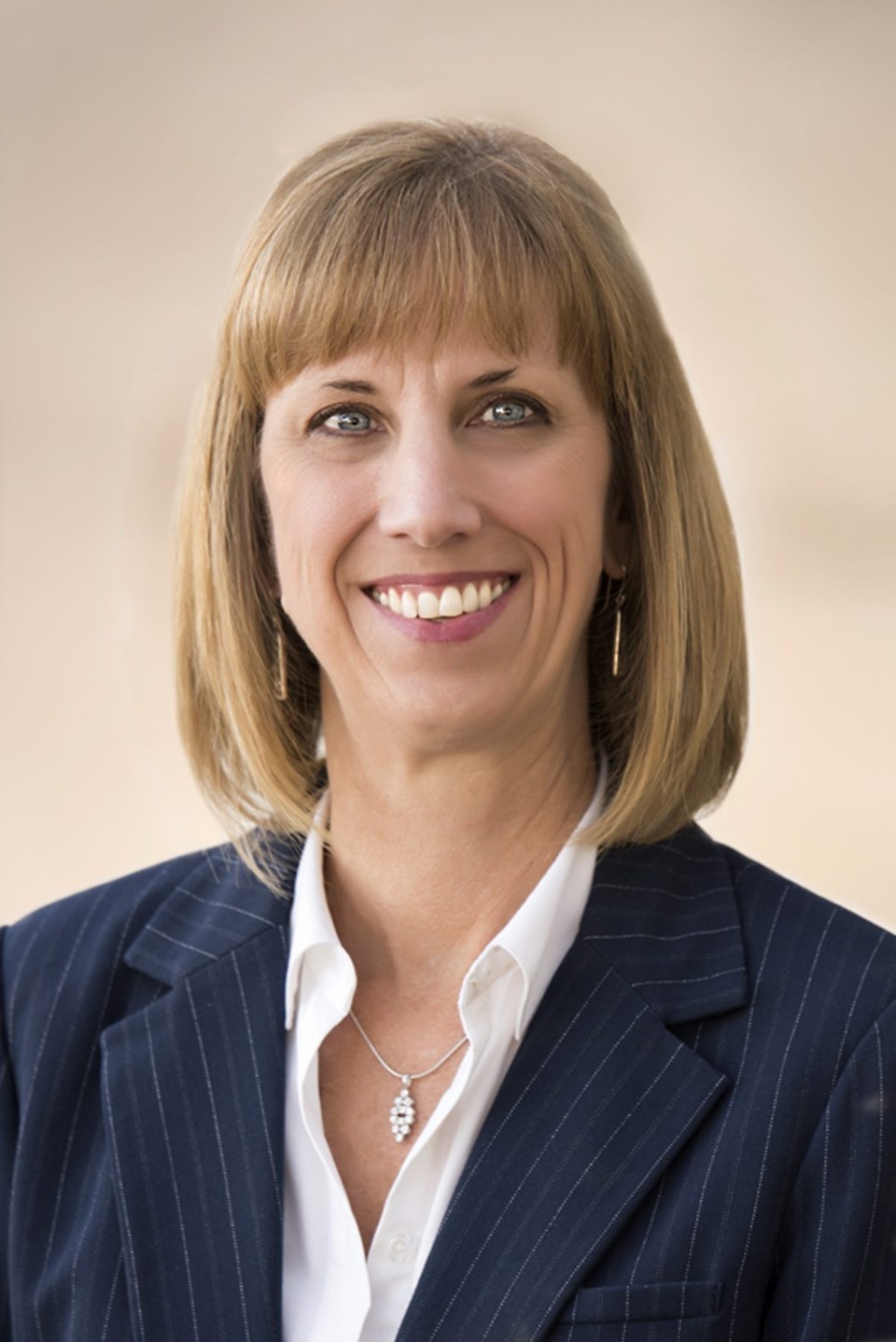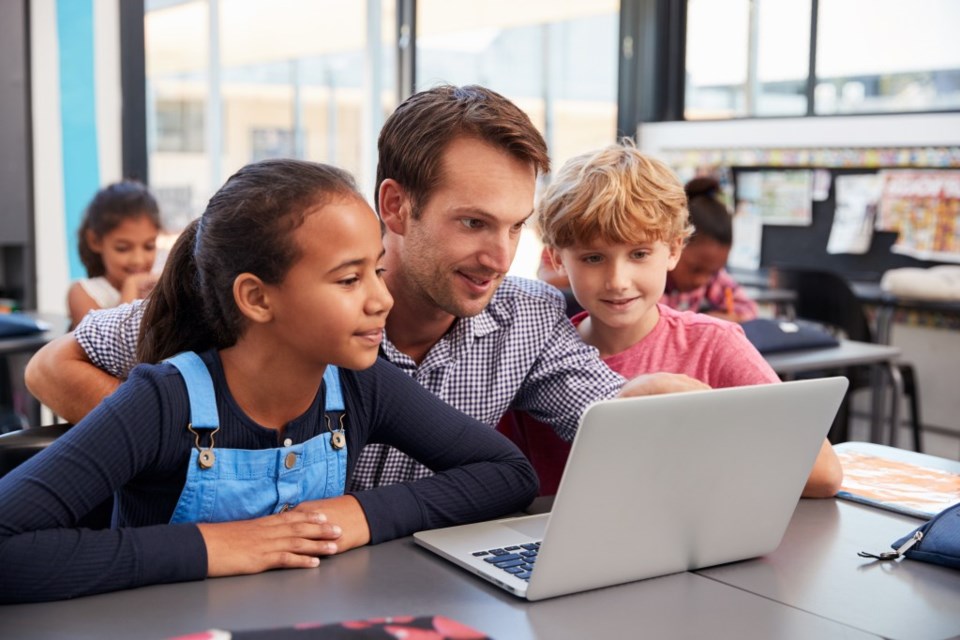Much of Sara Bonser’s goals for her superintendency originate from her own experience. Neither of Sara’s parents attended college, and as the third of four children, Sara was the first to go. “I am the AVID student. We didn’t have AVID then, but that was me,” Sara says, “I had the motivation, I had the desire, but I didn’t have the family experience of someone saying ‘This is what you do to get into college’. I had to beg to take my first honors class. I had to go to the counselor and beg for it.”
Sara’s zeal for academics led her to take a business education class in high school. “I took [this class] because I was interested in it and then it became my career, my life choice. I feel so strongly that this is a time in your life to start to ask ‘What do I want? What am I interested in?’ And then do it!”
Sara Bonser wants to ensure continuous improvement in student learning. This encompasses initiatives ranging from bringing specially adapted Chromebooks to every school in Plano, to implementing Social-Emotional Learning and GPA and class rank changes.
By encouraging sound physical and mental health, Sara wants PISD’s children to have the tools and freedom to develop their interests and their character beyond pure academics.
“I feel like your time in Plano schools should be a time to explore interests and passions. If you want to take a class just to see if you like it, this is the time to figure that out. You know, you get to college and again you’re trying to widen your interests, but it starts to narrow pretty fast. So if we don’t allow that exploration here, when will that happen for kids?”
GPA and Class Rank Changes
Plano ISD will now operate on two GPA systems: “Cumulative GPA” and “Ranking GPA”. Cumulative GPA, as the name suggests, encompasses all the classes that a student is taking and will be reported on the student’s transcript. Just to be clear, the Cumulative GPA is what PISD uses currently. The school district will continue to calculate Cumulative GPA and report it on a student’s transcript. However, while PISD currently uses Cumulative GPA to determine student ranking, they will now use Ranking GPA for that purpose.
Starting with this year’s incoming batch of 9th graders, a student’s Ranking GPA will only incorporate grades received in “math, science, social studies, and English [courses] which the state of Texas has identified as eligible to count toward a graduation requirement”.
AP European History, for example, is one course that will no longer count towards rank because it doesn’t align with the state of Texas’s graduation requirements, regardless of the fact that it’s a social studies course. Electives like music and athletics won’t count towards Ranking GPA either.
While in the past, continuing on with these classes would be detrimental to a student’s rank, this will no longer be the case. The new Ranking GPA will enable students to pursue their interests without fear of penalty.
PISD will also only be ranking students in the top 10% of every campus. The valedictorian and salutatorian will be notified of their rank, and other students in the top 10% will have the opportunity to inquire about their rank if they wish.
Why rank only the top 10%?
In 2015, the PISD Board of Trustees asked the school district to start looking into the impact of ranking on college admissions.
“What we noticed is that we have highly competitive kids in Plano ISD, kids who are very college ready, and they’re getting put on waitlists or not getting into the college of their choice even though they’re very qualified. [And it’s] because of ranking,” says Sara.
“There are school districts that have very little AP, but they rank. If you look at a student ranked in the top at one of those districts who hardly ever took any AP courses, and then you look at a Plano student, [our student is more prepared]. Within the distance between a four and a five in GPA are a lot of kids, and they’re all college ready! They’ve all taken several college-level, rigorous courses.”
“What you want is to know that a college admissions officer is looking at the whole package of you: your grades, your resume, your transcript, your extracurriculars, your community service. If they can purely eliminate you based on a number in their computer, [they won’t see all of that]. We want colleges to look closely at the Plano students so that they see them, not just a number. Because all numbers are not equal. They’re relative.”
Heart of a Scholar
Why does PISD offer so many AP classes? To provide all students with the opportunity to prepare themselves for the rigor of college.
As a high school student, I know that AP classes have become associated with the frenzied desire to boost our GPAs. I get it. But now that a majority of these classes aren’t part of Ranking GPA, the true purpose of these classes is coming through: to prepare us for college rigor.
I also know that your AP classes are probably chock-full of the kids already known for being high achievers. But that’s about to change.
“A couple of years ago, we saw that [in] our highest level courses, the seats weren’t filled with kids who had the potential to be successful,” says Sara Bonser. Thus, the district started focusing on their “commitment to equity”, encouraging that every student who can take the most rigorous courses, should.
Years ago, Sara had to beg her counselor to let her take honors classes. “[Now] we’re providing information to parents who, like mine, would’ve really benefited from what we call the ‘Heart of a Scholar’ program,” she says.
The program gives parents and students the information and resources to navigate through advanced academics.
“When I was principal at Williams, I spent a lot of time on equity work, and I realized that some kids just needed different support. Maybe they needed resources. Maybe they needed information. Maybe they just needed a different kind of tutorial. [Once they received these things] the kids always, always exceeded our expectations. That’s the kind of system that I want us to have districtwide. I’m excited about that work because it’s very meaningful.”
Social-Emotional Learning
SEL, as defined by PISD, is “an educational process through which skills for life effectiveness are intentionally taught and modeled in a safe, supportive, and culturally responsive environment”. It encompasses teacher training at the elementary, middle, and high schools levels, as well as various programs implemented across the board that enable students to develop a healthy state of mind.
“[We want to] balance rigor for all with social and emotional health. Sometimes, those things don’t line up well, and the pressures of society around us make those things hard to coexist,” says Sara Bonser. “We want kids to be challenged to their maximum, but we also want them to be happy, healthy kids who are preparing to become happy, healthy adults.”
Mark Allen, Executive Director of Student and Family Services at PISD, describes SEL as a means of “[helping students] understand that their brains are reacting”, and then giving them the tools to change the brain’s reaction.
Read more: The next generation: Young minds of Plano speak to the community
Many elementary schools have daily morning circles where they focus on one question. “[It could be] as simple as ‘what’s your favorite restaurant?’ or ‘what’s your favorite food?’ or ‘what do you do in the summer?’”, says Mark Allen. The point of a morning circle isn’t necessarily to discuss academics. “[Circles] helps kids build connections with each other, and it also helps them build connections with their teachers.”
Other elementary classrooms perform “feelings checks”. Kids can develop an understanding of how their friends are, and then teachers can check up on kids that may need more attention. Other classrooms keep “calm-down boxes” or “calm-down corners”. When kids become dysregulated, they can be directed to the space or the tools they need to process their feelings.
Many high schools and middle schools are implementing circles into the school week as well. Another high school initiative is the research-based Youth Awareness of Mental Health (YAMS) program. YAMS was created at UT Southwestern and is currently being incorporated in high school health classes.
“The purpose of [YAMS] is to destigmatize mental health. We’re hoping that through these lessons, students will feel more able to reach out to adults,” says Mark Allen.
While counselors in PISD, especially at the elementary level, have been implementing guidance lessons for years, the focus on SEL is to expand those lessons into a student’s everyday life.
“We’re creating a better world by doing this,” says Mark.
Visit PISD’s website for more information on SEL.
One-to-Web
The goal of One-to-Web is to get one Chromebook in the hands of every student in PISD plus 2 percent extra, to accommodate for extra growth of enrollment. The program started in 2016 and is currently rolling out Chromebooks in phases. As part of the commitment to equity effort, students in Title 1 schools, with a higher percentage of economically disadvantaged kids, received their Chromebooks first. By the end of this year, every high school student will have access to their own device while at school.
“[We want every student to have a] tool for global thinking and 21st century skill development. It shouldn’t just be a substitute for an overhead projector,” says Sara Bonser. For this reason, the devices for PISD campuses are specially adapted for student needs.
“They’re actually more durable. They redesigned some of the exterior based on our specifications. We knew the wear and tear that they were going to have,” Sara laughs. The Chromebooks also have software specific to our needs, and in some cases, they interact with students differently. For example, the Chromebooks going to elementary schools will have facial recognition!
“I have a son in high school, but when he was in elementary school, the hardest part of his day was going to computer class because he couldn’t remember his password,” says Lesley Range-Stanton, PISD’s Executive Director of Communications. “He had anxiety about it, so that recognition sounds amazing.”
Campuses will decide how they can structure the school day to get the most out of their Chromebooks. For example, as of last year, students at Jasper High School have been attending seventh period first. They pick up their Chromebooks and carry them throughout the day. Then, they return them once they end up in seventh period again at the end of the day. “That way, they don’t lose time having to log on and off,” says Sara.
A Philosophical Shift
The result of each of these initiatives? A school district that prepares kids for life beyond academics. A ranking system that accommodates for students to pursue their interests, a school day that prepares kids on how to deal with their emotions, and a new generation ready to develop skills for a new era.
“It’s a philosophical shift for the district,” says Sara Bonser. And it encompasses everyone, from the students, to the teachers, to PISD administrators. “We’re all learning all the time. No double standards. What we expect of the kids, we expect of ourselves.”
Read more: PISD Board President Missy Bender shares her story and her hopes for PISD students






![Top 5 Reads Of The Week [June 23-27]](https://www.vmcdn.ca/f/files/localprofile/images/events/downtown-celina-city-of-celina.jpg;w=120;h=80;mode=crop)
